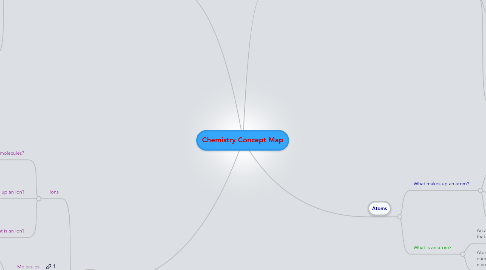
1. Particulate Model of Matter
1.1. Matter
1.1.1. 3 States
1.1.1.1. Solid
1.1.1.1.1. Movement
1.1.1.1.2. Arrangement
1.1.1.1.3. Energy
1.1.1.1.4. Forces of Attraction
1.1.1.2. Liquid
1.1.1.2.1. Arrangement
1.1.1.2.2. Movement
1.1.1.2.3. Energy
1.1.1.2.4. Forces of attraction
1.1.1.3. Gas
1.1.1.3.1. Arrangement
1.1.1.3.2. Movement
1.1.1.3.3. Energy
1.1.1.3.4. Forces of attraction
2. Ions
2.1. Ions
2.1.1. What are molecules?
2.1.1.1. A molecule is made out of two or more atoms combined together.
2.1.2. What makes up an ion?
2.1.2.1. Losing electron(s)
2.1.2.1.1. An atom which loses one or more electrons is now positively charged and known as a positive ion.
2.1.2.2. Gaining electron(s)
2.1.2.2.1. An atom which gains one or more electrons is now negatively charged and known as a negative ion.
2.1.3. What is an ion?
2.1.3.1. An ion is formed when an atom gains or loses electrons.
2.2. Molecules
2.2.1. Molecules of Elements
2.2.1.1. Molecules of elements consist of a fixed number of the same type of atoms combined together.
2.2.2. Molecules of Compounds
2.2.2.1. Molecules of compounds consist of a fixed number of two or more different types of atoms combined together.
2.3. Bonds
2.3.1. Ionic Bonding
2.3.1.1. This occurs only between metal and non-metal atoms.
2.3.1.2. Compounds formed by such bonds are called ionic compounds.
2.3.2. Metallic Bonding
2.3.2.1. Occurs only between metal atoms.
2.3.3. Terms
2.3.3.1. 'Ionic compounds' are used when substances consist of metal and non-metal atoms.
2.3.3.2. 'Molecules' is used when the substances consist of non-metal only.
2.3.4. Covalent Bonding
2.3.4.1. Occurs only between non-metal atoms.
3. Changes in Physical States
3.1. Gas------------------>Solid------------>Liquid-------->Gas (sublimation) (melting) (freezing)
3.1.1. Solids
3.1.1.1. Melting
3.1.1.1.1. 1. When heated, its particles gain energy and vibrate faster
3.1.1.1.2. 2. Strong forces of attraction which hold them together weakens and cannot hold them together as tight.
3.1.1.1.3. 3. The particles move further away from one another.
3.1.1.2. Sublimation
3.1.1.2.1. Same process but the particles change into gaseous state without going through the liquid state.
3.1.2. Liquid
3.1.2.1. Freezing
3.1.2.1.1. 1. When losing heat, its particles lose energy.
3.1.2.1.2. 2. The particles will then move slower as the forces of attraction strengthens.
3.1.2.1.3. 3. The particles will then move closer together.
3.1.2.2. Evaporation / Boiling
3.1.2.2.1. 1. When liquid particles are heated, it gains energy.
3.1.2.2.2. 2. They move and vibrate faster, moving further away from one another.
3.1.2.2.3. 3. Forces of attraction between the particles are no longer strong enough to hold them together
3.1.3. Gas
3.1.3.1. Condensation
3.1.3.1.1. 1. When losing heat, the particles lose energy.
3.1.3.1.2. 2. They move and vibrate slower and closer to each other.
3.1.3.1.3. 3. Forces of attraction between the particles strengthens, holding them tighter to each other.
4. Atoms
4.1. What makes up an atom?
4.1.1. An atom is electrically neutral entity made up of a positively charged nucleus with negatively charged electrons.
4.1.2. The atom itself is made up of even smaller particles called sub-atomic particles.
4.1.3. There is an equal amount of protons and electrons in an atom, the electric charges of the protons and neutrons balance each other.
4.2. What is an atom?
4.2.1. An atom is the smallest particle of an element that can exist.
4.2.2. Atoms of the same element contain the same number of protons and those of different elements contain different number of protons.
